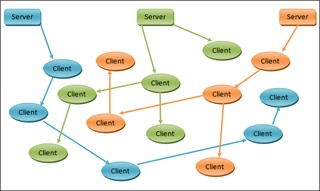Related Research Articles

Peer-to-peer (P2P) computing or networking is a distributed application architecture that partitions tasks or workloads between peers. Peers are equally privileged, equipotent participants in the network, forming a peer-to-peer network of nodes.

Streaming media is multimedia for playback using an offline or online media player. Technically, the stream is delivered and consumed in a continuous manner by a client, with little or no intermediate storage in network elements. Streaming refers to the delivery method of content rather than the content itself.

A wireless LAN (WLAN) is a wireless computer network that links two or more devices using wireless communication to form a local area network (LAN) within a limited area such as a home, school, computer laboratory, campus, or office building. This gives users the ability to move around within the area and remain connected to the network. Through a gateway, a WLAN can also provide a connection to the wider Internet.
BitTorrent, also referred to as simply torrent, is a communication protocol for peer-to-peer file sharing (P2P), which enables users to distribute data and electronic files over the Internet in a decentralized manner. The protocol is developed and maintained by Rainberry, Inc., and was first released in 2001.
MLDonkey is an open-source, multi-protocol, peer-to-peer file sharing application that runs as a back-end server application on many platforms. It can be controlled through a user interface provided by one of many separate front-ends, including a Web interface, telnet interface and over a dozen native client programs.
Direct Client-to-Client (DCC) is an IRC-related sub-protocol enabling peers to interconnect using an IRC server for handshaking in order to exchange files or perform non-relayed chats. Once established, a typical DCC session runs independently from the IRC server. Originally designed to be used with ircII it is now supported by many IRC clients. Some peer-to-peer clients on napster-protocol servers also have DCC send/get capability, including TekNap, SunshineUN and Lopster. A variation of the DCC protocol called SDCC, also known as DCC SCHAT supports encrypted connections. An RFC specification on the use of DCC does not exist.
An anonymous P2P communication system is a peer-to-peer distributed application in which the nodes, which are used to share resources, or participants are anonymous or pseudonymous. Anonymity of participants is usually achieved by special routing overlay networks that hide the physical location of each node from other participants.

A content delivery network or content distribution network (CDN) is a geographically distributed network of proxy servers and their data centers. The goal is to provide high availability and performance by distributing the service spatially relative to end users. CDNs came into existence in the late 1990s as a means for alleviating the performance bottlenecks of the Internet as the Internet was starting to become a mission-critical medium for people and enterprises. Since then, CDNs have grown to serve a large portion of the Internet content today, including web objects, downloadable objects, applications, live streaming media, on-demand streaming media, and social media sites.
An overlay network is a computer network that is layered on top of another network. The concept of overlay networking is distinct from the traditional model of OSI layered networks, and almost always assumes that the underlay network is an IP network of some kind.
Alluvium is open source peercasting software developed by the Foundation for Decentralization Research, first released in 2003. It comprises three components, Core, Media Player, and Server. Alluvium allows video and audio programming to be broadcast over the Internet using swarming technology. It is powered by Onion Networks' Swarmcast, and is notable for its incorporation of server-side time-based playlists, and client software which examines those playlists and begins streaming content from the server(and available peers) per that schedule, simplifying the creation of continuous-broadcast video and audio.

P2PTV refers to peer-to-peer (P2P) software applications designed to redistribute video streams in real time on a P2P network; the distributed video streams are typically TV channels from all over the world but may also come from other sources. The draw to these applications is significant because they have the potential to make any TV channel globally available by any individual feeding the stream into the network where each peer joining to watch the video is a relay to other peer viewers, allowing a scalable distribution among a large audience with no incremental cost for the source.
Adobe Media Server (AMS) is a proprietary data and media server from Adobe Systems. This server works with the Flash Player and HTML5 runtime to create media driven, multiuser RIAs. The server uses ActionScript 1, an ECMAScript based scripting language, for server-side logic. Prior to version 2, it was known as Flash Communication Server. Prior to version 5, it was known as Flash Media Server. In February 2019, Adobe Systems Incorporated granted Veriskope Inc rights to further develop, resell, and extend distribution of the software product.
RawFlow was a provider of live p2p streaming technology that enables internet broadcasting of audio and video. The company's technology is similar to Abacast and Octoshape.

Tribler is an open source decentralized BitTorrent client which allows anonymous peer-to-peer by default. Tribler is based on the BitTorrent protocol and uses an overlay network for content searching. Due to this overlay network, Tribler does not require an external website or indexing service to discover content. The user interface of Tribler is very basic and focused on ease of use instead of diversity of features. Tribler is available for Linux, Windows, and OS X.
This is a glossary of jargon related to peer-to-peer file sharing via the BitTorrent protocol.
Red Swoosh was a peer-to-peer file sharing company founded by Travis Kalanick and Michael Todd in 2001. It was acquired by Akamai in 2007 for $19 million.
End System Multicast (ESM) was a research project at Carnegie Mellon University. It developed a peercasting system for streaming live, high-quality video and audio to large audiences.
The Secure Real-Time Media Flow Protocol (RTMFP) is a protocol suite developed by Adobe Systems for encrypted, efficient multimedia delivery through both client-server and peer-to-peer models over the Internet. The protocol was originally proprietary, but was later opened up and is now published as RFC 7016.

libtorrent is an open-source implementation of the BitTorrent protocol. It is written in and has its main library interface in C++. Its most notable features are support for Mainline DHT, IPv6, HTTP seeds and μTorrent's peer exchange. libtorrent uses Boost, specifically Boost.Asio to gain its platform independence. It is known to build on Windows and most Unix-like operating systems.
Traffic classification is an automated process which categorises computer network traffic according to various parameters into a number of traffic classes. Each resulting traffic class can be treated differently in order to differentiate the service implied for the data generator or consumer.
References
- ↑ Buford, John F.; Yu, Heather; Lua, Eng Keong (2008). P2P Networking and Applications. Morgan Kaufmann. p. 203. ISBN 978-0-12-374214-8.
- ↑ Garbinato, Benoît; Miranda, Hugo; Rodrigues, Luís (2009). Middleware for Network Eccentric and Mobile Applications (1st ed.). Springer. ISBN 978-3-540-89706-4.